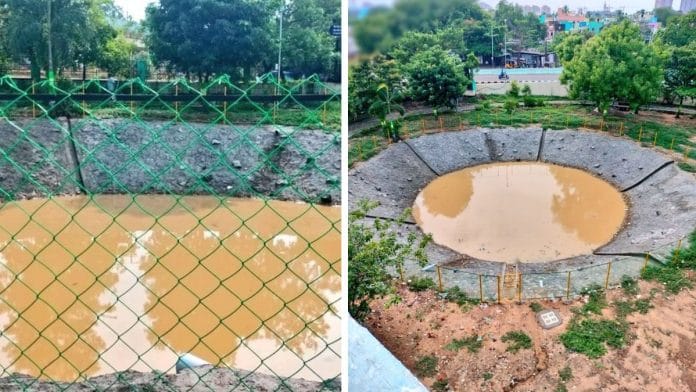Chennai: To floodproof Chennai and increase its green cover, the Greater Chennai Corporation (GCC)—the city’s civic body—is focusing on a massive tree plantation drive this year and converting existing open spaces into sponge parks.
Sponge parks are open urban spaces with pond-like structures that can absorb water to prevent flooding, and boost groundwater recharge. A small pond-like structure is excavated in the low-lying area of a park, so that excess water is diverted towards that structure. It also has pipes inserted to filter the water and boost groundwater recharge.
The GCC has set a target of planting about 2.5 lakh trees across Chennai this fiscal year as well as creating 31 new sponge parks. Work on creating the sponge parks started this week and is expected to be complete before the onset of the northeast monsoon by the end of October, a GCC official who did not want to be named told ThePrint.
In 2022-23, the GCC had converted 57 open spaces into sponge parks, as part of its plan to increase Chennai’s green cover. These included My Lady Garden in north Chennai’s Periamet and a park in Second Main Road, VGP Selva Nagar in south Chennai’s Velachery.
The plan is to build on that initiative and have more such pond-like water retention structures across the city.
In December last year, Chennai witnessed heavy floods due to the torrential rains triggered by Cyclone Michaung, which caused 17 casualties. This year, the GCC as well as the state government is being cautious about its rain preparedness after receiving criticism post last year’s deluge. Tamil Nadu Deputy Chief Minister Udhayanidhi Stalin has himself been supervising the work.
The official quoted above said the GCC is spending about Rs 10-30 lakh on each of the 31 sponge ponds that the civic body is building. These sponge ponds will be built in areas that were worst affected by the 2023 floods, including Manickam Pillai Street in western Chennai’s Korattur (Zone 7 of the corporation) and Ranga Avenue Park in northern Chennai’s Madhavaram (Zone 3).
ThePrint has reached GCC chief engineer (general) S. Rajendiran, who is directly in charge of these projects, for a comment. This report will be updated if and when a response is received.
Also Read: TN govt launches portal to issue instant approval for building permits via self-certification
Increasing Chennai’s green cover
Chennai is the hottest megacity in India, according to a June 2024 study by the New Delhi-based environmental research and advocacy organisation Centre for Science and Environment (CSE).
Currently, the green space per capita in Chennai is 8.75 square metres per person, which is unhealthy as it is well below 9.5 square metres—the green space per capita recommended by the World Health Organization (WHO) for healthy living.
The official quoted above said that the corporation aims to plant about 2.5 lakh trees across the city, including in parks, playfields and other available public spaces, by collaborating with NGOs and welfare associations in 2024-25. As part of this plan, about 41,000 saplings developed in GCC’s nursery have been planted across the city as of April, he said.
According to GCC officials, there are 37 Miyawaki forests (dense, multi-layered forests created using the Japanese afforestation technique of planting native trees at high densities) and 871 urban parks in the city, which are maintained by the civic body. These Miyawaki trees have about 1,24,929 trees.
“To add to these, the GCC is implementing many measures to reduce the heat island effect. Work on restoring water bodies began in 2021 and is still ongoing. So far, 194 water bodies have been restored,” a second GCC official, who also wished not to be named, told ThePrint.
A third of TN to be green
The second official quoted above added that the GCC’s interventions are part of the Green Tamil Nadu Mission, launched by Chief Minister M.K. Stalin in September 2022. The target of expanding the state’s green cover to 33 percent was also mentioned in this mission document. Tamil Nadu is expected to meet this target by 2030-31, she said.
For this, both officials said, the GCC is collaborating with the Chennai Metropolitan Development Authority (CMDA) to ensure that Open Space Reservation (OSR) land is converted into green spaces.
According to the Tamil Nadu Combined Development and Building Rules (TNCDBR), 2019, owners should reserve 10 percent of their land as open spaces if the area of the land is above 10,000 square metres.
“CMDA is creating an inclusive third master plan for the city, wherein the GCC, TN’s Water Resources Department (WRD), Chennai Metropolitan Water Supply and Sewerage Board (CMWSSB), and other stakeholders are included,” the second official said.
(Edited by Radifah Kabir)
Also Read: Tamil Nadu is on a mangrove mission to create ‘bio-shields’. Villagers are on the frontlines






